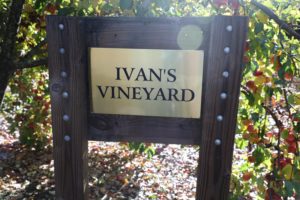
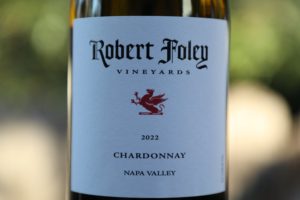
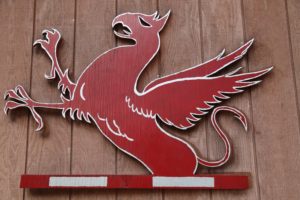 Robert Foley Vineyards is run by the talented winemaker Bob Foley and his wife Kelly. Bob remembers his first trip to Napa was in 1964 with his father to pick out some grapevines from a well-known rootstock nursery that no longer exists in St. Helena. His father wasn’t making wine commercially – he just wanted to have fun growing grapes and did so with a small vineyard in the family back yard. Robert remembers his father meeting with Dr. Harold Olmo at UC Davis and asking for advice on how to grow and manage these. In later years, Dr. Olmo would serve as Robert’s adviser during his time at UC Davis.
Robert Foley Vineyards is run by the talented winemaker Bob Foley and his wife Kelly. Bob remembers his first trip to Napa was in 1964 with his father to pick out some grapevines from a well-known rootstock nursery that no longer exists in St. Helena. His father wasn’t making wine commercially – he just wanted to have fun growing grapes and did so with a small vineyard in the family back yard. Robert remembers his father meeting with Dr. Harold Olmo at UC Davis and asking for advice on how to grow and manage these. In later years, Dr. Olmo would serve as Robert’s adviser during his time at UC Davis.
A neighbor, Bill Miller (worked for a company that distributed Inglenook wines) and ultimately is the man responsible for introducing Robert to the wine industry. Robert’s “aha” wine moment came when Bill took him to Inglenook Winery in St. Helena and gave Robert a cask sample of a very little produced variety in Napa Valley and beyond – Charbono. He tried a 1968 vintage – and immediately wanted more of this wine. Bill encouraged him to further his education; Robert then enrolled at UC Davis and graduated with degrees in both oenology and viticulture.
Robert has been wine making in Napa Valley since 1977; his first winery job was for Joe Heitz at Heitz Cellars which puts him in a select number of unfortunately dwindling winemakers still practicing their art today who were working in the 1970s in Napa Valley. He was also the founding winemaker at Markham Vineyards where he made their wines for 15 years followed by another 15 years as winemaker at Pride Mountain Vineyards. He is among a select group of Napa Valley winemakers who seem ageless; we would also put Rudy Zuidema of Zuidema Wines and Ren Harris of Paradigm Winery in that ‘ageless’ category. If you ever get the chance to meet Bob you will soon realize his passion for both his winemaking and the wine industry is an important part of his being. Running his own winery which produces around 8,000 cases a year certainly keeps him busy. But he is also the winemaker for several other small wineries based in Napa Valley.
After many years of custom crushing at local wineries, he purchased and moved his operations to Howell Mountain in 2006. Vines were already planted on site dating to the late 1990s; Robert Foley has since planted additional vines and there are now 5 acres planted to Cabernet Sauvignon and Merlot. These vineyards are approximately at 2000 feet, keeping in tradition with some of the other vineyards that Bob sources from, focusing on hillside regions within Napa Valley. And he primarily works with vineyards that he owns or leases.
Robert is very careful about which vineyards he sources from. He must have full control over the farming. He met vineyard manager Hector Lopez when they were both working at Pride Mountain. Today he speaks of Hector as “an extension of himself” and calls him a “Zen Gardener”. Hector’s family has been managing grapes in the Napa Valley for many years – he was initially attracted to Robert’s attention to detail in managing vineyards.
As a result of the hillside grown grapes and vineyard management practices, Robert Foley wines are typically well concentrated both in aroma and flavor. And they have good acidity; these are wines that are built to last.
Over the years Robert has added wines to his portfolio. Case in point is their Pinot Noir. 2010 was the first ever vintage of Pinot Noir under the Robert Foley label. However, this was not the first time Robert has produced wine from this variety. He was the founding winemaker at Markham Vineyards and the year was 1978. Markham was making wine from a vineyard in Napa that was planted to several Pinot Noir clones including Gamay Beaujolais.
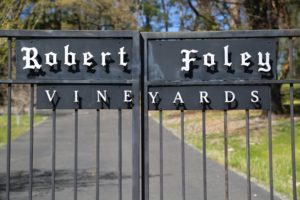
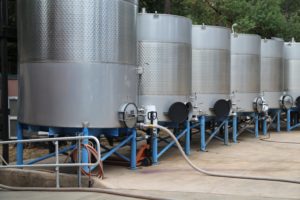
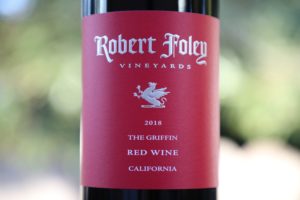 Wanting to learn more about how Pinot Noir was historically produced, Robert took a trip to Burgundy and met with those working with this variety. Armed with new viticulture and oenology knowledge about how to treat this variety – as well as some cuttings – he came back to Napa and planted these.
Wanting to learn more about how Pinot Noir was historically produced, Robert took a trip to Burgundy and met with those working with this variety. Armed with new viticulture and oenology knowledge about how to treat this variety – as well as some cuttings – he came back to Napa and planted these.
One day, a number of years after no longer making wine at Markham Vineyards, he received a call from one of their employees informing him how well a certain bottle of Pinot Noir had aged after 10 years. He complemented Robert by telling him it was very Burgundian in style. This was the perfect validation of Robert’s research in France and his work with this variety.
He also made a Pinot Noir for Schoolhouse Vineyards for more than a decade (one of Napa’s oldest producers, first vintage 1957). For many years he never had access to some of the premium Pinot Noir vineyards in Napa Valley despite clients and friends continuously asking him to bottle a Pinot Noir under the Robert Foley brand. Ultimately a friend introduced him to Lee Hudson – a well-respected grower in the Carneros region of Napa Valley and Robert now sources grapes from a particular block within this vineyard each year.
Family Hollywood Connection
Bob’s grandfather was John (Jack) Donavan Foley, the man responsible for developing sound effect techniques which continue to be used by the film industry. Born and raised in New York he moved to California in 1914 for better weather, settling in the town of Bishop in the Owens Valley in California’s eastern Sierra Nevada mountains. His work involved guarding the water supply and canals for the American Defense Society. Water from the Owens Valley was delivered to residents of Los Angeles several hundred miles to the south via canals.
Nowhere in California does the west feel more alive than in the Owens Valley. These are the quintessential landscapes that drew pioneers to this part of the country. With a dramatic backdrop of the state’s most impressive mountains guiding one up and down the great 395, one is never far from inspiration. If there was a god of nature, she would live in this valley. If there was one small town we would live in at least seasonally, based on the perspective cultivated from years of travel around the world it would be Independence or Lone Pine. And perhaps it would be in Mary Austin’s old home.
In the 1920s Foley worked to bring filming to Bishop and vicinity and he helped scout film locations. Through this work he connected with Universal Studios where he began work as a stunt man and also directed silent films. His career and influence became more prominent as sound was introduced to films in the later part of the 1920s. he worked for Universal Studios for nearly 30 years as a sound man, creating a diversity of sounds for numerous films including several prominent productions: Dracula (1931) and Spartacus (1960).
His work was so influential his last name became the standard for referring to reproducing sounds needed for films (i.e., walking, loud breathing, breaking glass, typing on a keyboard, etc.). One of his most common jobs to reproduce sound was walking – trying to match the pace and gait of who he was imitating on the big screen. An article in the March 18, 1960 edition of the Los Angeles Mirror provides some insight into his work. Foley said, “women are the toughest to imitate, my 200 pounds may have something to do with it, but the important thing is that their steps are quicker and closer together. I get winded doing leading ladies”. When he retired in the mid 1960s, he was the Head of the Sound Effects Department at Universal Studios.
Those who work in this business are referred to as Foley artists. And Disney Studios maintains the Foley Vault, a collection of original Foley recordings.
Foley is buried at the San Fernando Mission Cemetery in Los Angeles. Incidentally another vintner with connections to Hollywood and Napa Valley, Francis Ford Coppola’s father Carmine Coppola is also buried in this same cemetery.
And Robert’s uncle John Foley Jr., also worked in the film industry as an editor including on an episode of Star Trek in 1966 and also for DESILU PRODUCTIONS, a company operated from 1950 to 1967 founded by husband and wife Desi Arnaz and Lucille Ball. Foley Jr., worked closely with Lucille Ball and edited THE LUCY SHOW and HERE’S LUCY. Incidentally Ball was in one of the more well-known scenes in movie history, the grape fighting/stomping scene in the 1956 episode of I LOVE LUCY (Lucy’s Italian Movie), still referenced today, primarily by visitors to wine country.
Select Wines
Whites
The 2022 Robert Foley Vineyards Chardonnay (Oak Knoll District). If we could chase one season around the planet each year it would be spring and the resulting smells when vegetation is renewed and blooming, days are getting longer and temperatures are increasing. This wine is medium golden in the glass; the bouquet reminds us of spring; it is fresh, fruity, floral and alive. This wine sports aromas of honeysuckle, star jasmine, orange blossom, pineapple, pear, and honey crisp apple. This latter aromatic is still fresh in the mind from the amazing apples we harvested from the two trees growing along the Robert Foley driveway. These are not always scents one associates with a Napa Valley grown Chardonnay and in a blind tasting we might mistakenly guess this was a Sauvignon Blanc from aromatics alone. The palate reveals flavors of honeycomb, apricot, pineapple, yellow peach, mango, lychee and pear. Its texture is creamy and rounded and complements nicely the rich flavors and bright acidity, especially noticeable on the finish. It does not go through malolactic fermentation.
This is the last white wine of 2023 we tasted and wrote about after another *extremely intense* year of tasting up and down the valley. For us, this is a wine of anticipation, one of warmer days ahead, friendly people, some of the best food on the planet and relaxation. All starting next week when we leave for our annual always much needed several month winter break in Thailand.
Charbono
Charbono is extremely limited in production with most of these vineyards in the USA grown in and around the Calistoga area. It’s genetic history dates to the French Alps of the Savoie region and when it was translated into English, it was known as the “Soft Black” grape. Charbono thrives with temperature swings during the growing season and Calistoga certainly has these. The northern part of the Napa Valley is the warmest but during the summer nights the temperature can drop 30 and 40 degrees from that day’s high.
Inglenook was known in part for their long-lasting Charbono’s produced in the 1960s and 1970s; the very few of the 1970s bottlings we have tried (thank you Bern’s Steakhouse in Tampa, Florida) have held up remarkably well. Inglenook stopped making this wine years ago. Robert wasn’t sure it was even still grown in Napa Valley. Then he discovered the Heitz Family in Calistoga and was told their vineyard was supplying this variety to Inglenook and was used in the Inglenook 1968 Charbono. For Inglenook, it bottled as 100% varietal but was also used for blending into their Cabernet Sauvignons.
When Robert reached out to the Heitz family, he realized they were resigned to the fact that they were going to have to pull out the vines and plant another variety due to the lack of demand for Charbono. Robert informed them that he would purchase their grapes and has done so every year since. He typically produces around 600 cases of this wine; he used to produce even more. There are only a handful of Charbono producers in Napa Valley; Robert Foley is currently largest producer of wines from this variety in Napa Valley.
Charbono produces wines dark in color with lower acidity but higher pH, lower alcohol and no pyrazines (the compound resulting in a green character). It is also a highly tannic wine so careful tannin management both in the vineyard and in the cellar is required. Charbono can be a challenging variety to grow as bud break comes very early in the season, typically before the frost season is over and it can be extremely slow to ripen. It reaches its phenolic maturity often when the sugars are still much lower than other red varieties. It does well in Calistoga because of the diurnal temperature difference between day and night which is often 30-45 degrees on a summer day. It can also be blended, even in small percentages to coax out fruit characteristics of other varieties.
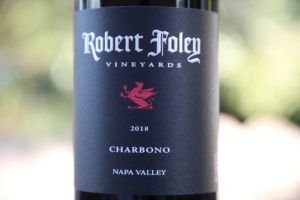 Charbono inherently stops producing sugar at some point during the end of summer – usually around 22 or 23 brix and the maturation of the skins comes later. As a result, the wines made from this variety are typically lower in alcohol than what is now the average in Napa Valley for red wine. It is rare when their Charbono reaches 13%.
Charbono inherently stops producing sugar at some point during the end of summer – usually around 22 or 23 brix and the maturation of the skins comes later. As a result, the wines made from this variety are typically lower in alcohol than what is now the average in Napa Valley for red wine. It is rare when their Charbono reaches 13%.
Napa Valley based winemaker Rory Calder and grower of Charbono told us in his research he spotted records of Charbono planted in Amador County in California’s Sierra Nevada foothills dating back to at least the 1870s. Charbono is also known as Bonarda, a popular variety in Argentina. However, it is not currently well-known in California; in fact, there are only approximately 70-80 acres of this variety planted in the state and according to the 2018 Napa County crop report, 44 bearing acres of Charbono grow in Napa Valley, a significant amount of that near Calistoga.
The 2018 Robert Foley Vineyards Charbono Napa Valley is deep ruby and opaque in the glass; the bouquet is darkly fruited with aromas of plum and blackberry, paralleled by dark and savory aromatic layers including sweaty baseball mitt being used on a hot day, a meaty/gamey character, dried sage and old cedar box. A note of dark chocolate becomes more pronounced as this wine evolves in the glass. The focus of the palate is clearly on the fruit, and as compared to the bouquet, there is a lesser emphasis on savory notes. It reveals flavors of dark plum, blackberry, mulberry and blackberry. We love the fact that the palate shows perfectly ripe but the alcohol is only 12.9%. And the tannins are kept in check very well; their texture is polished and supple lingering gently on the seamless finish. More people would certainly become fans of this variety after trying the Robert Foley Charbono.
The 2012 Robert Foley Vineyards Charbono Napa Valley is 12.5% alcohol. It is dark in color; the bouquet breathes darker aromas showing somewhat floral accompanied by notes of blackberry and dark cherry with a woodsy spice and cedar nuance. This wine showcases bright acidity and layers of fruit; it is light to medium bodied in terms of texture. The tannins are certainly there but are not out of balance or robust – rather are integrated and linger for some time. Charbono is a variety that produces wines that will age remarkably well with some vintages going even further than Cabernet Sauvignon.
Other reds
The 2018 Robert Foley Vineyards Kelly’s Cuvée Syrah, Solari Vineyard (Calistoga, 100% varietal) Napa Valley is deep ruby and opaque in the glass; the bouquet bursts with layered, dark, ripe and sweetly fruited aromatics; if this wine was a personality at a party, it would be the most talkative and engaging person in the room. It offers scents of ripe plum, blackberry, boysenberry, black cherry, Pakistani mulberry, melting brown chocolate, pie crust, mocha and several components of allspice. The palate is intensely flavored, plush and hedonistic but without any heavy handed tannic grip. Rather its texture features polished and spherical shaped tannins (lightly grainy) which linger along with the fruit on an extended and seamless finish. The inception for this bottling was in 2010; the Syrah that year was initially going to be blended in Kelly’s Cuvée but Kelly preferred how the Syrah stood out on its own.
The 2018 Robert Foley Vineyards The Griffin, Red Table Wine is a blend of 44% Merlot, 40% Petite Sirah, 14% Syrah and 2% Charbono. The varietal percentage for this bottling changes every vintage. This wine is deep ruby and nearly opaque; the bouquet sports aromas of Santa Rosa plum, blackberry, dark cherry, dark chocolate, cocoa powder, mole and a note of tobacco spice. Brightly lit across the palate in terms of both acidity and flavor, this wine offers notes of plum, cherry, bramble, blueberry, cedar and hints of dark pepper. The tannins are broadly distributed across the palate and sport a grainy, rounded and cushiony texture. Both fruit and tannins parallel each other on the long finish. Lingers with a light and almost chalky drying character. From tasting this, one would be hard pressed to guess this wine is 15.5% alcohol as listed on the label. It overdelivers for the price.
2011 was not a bad year for the Robert Foley wines; in general this year is accepted as one of Napa’s more challenging vintages in recent years. However, Robert has been making wine in Napa Valley so long he has the perspective to know this wasn’t his most challenging year. He recalls 1998 as a particularly difficult vintage and remembers meeting a fellow winemaker leisurely grocery shopping in St. Helena in October. This normally is a very busy time of year during harvest. Robert remembers the conversation began something like this: “Robert, have you ever picked your grapes after all the leaves have dropped off the vines?”!
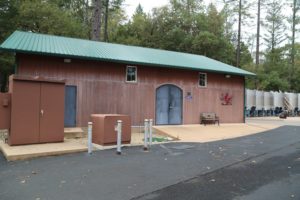
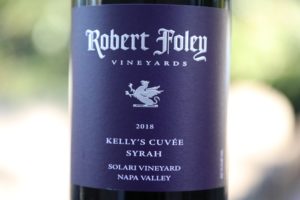 In general, 2011 was a cold and wet year with rain into June and precipitation starting particularly early in September. Robert Foley their grapes as dry as possible, even bringing out leaf blowers to selectively dry out bunches on each vine. But geographically they were also helped by the fact that many of their vineyards are located on the hillsides.
In general, 2011 was a cold and wet year with rain into June and precipitation starting particularly early in September. Robert Foley their grapes as dry as possible, even bringing out leaf blowers to selectively dry out bunches on each vine. But geographically they were also helped by the fact that many of their vineyards are located on the hillsides.
The 2012 Robert Foley vineyards Pinot Noir is dark in the glass, noticeably so for this variety. Based on color alone, one might think it was produced from another variety such as Syrah or Cabernet Sauvignon. The aromas show darker fruits but are also accompanied by hints of white pepper and baking spice along with some floral notes. The wine is fairly soft on the palate. Like a number of other Robert Foley wines we tried, this one showcases bright acidity. Fine grained tannins linger along with red fruit flavors.
The 2011 Robert Foley Vineyards Claret is 80% Cabernet Sauvignon, 17% Merlot and 3% Petit Verdot; this small percentage of Petit Verdot helps elevate the aromas as well as provides some acidity to the wine. It is dark in the glass with an appealing expression of layered primarily dark and ripe fruit aromas including blackberry and black currant. The mouth feel is luscious with a rich complexity of fruit – this is a robust wine with well-structured tannins on the finish hitting all parts of the palate. It opens up dramatically as it breathes, soon revealing notes of leather and tobacco. This bottling is definitely a candidate for aging if you can resist drinking it now. Robert Foley has built a strong and loyal following around this wine over the years; it was the first wine Robert bottled under his label in 1998.
The Robert Foley Vineyards Merlot was first bottled in 2005 as a 100% varietal wine. The 2011 Robert Foley Merlot was sourced from both Howell Mountain and Calistoga vineyards. This is 100% varietal. The sweetly fruited and attractive bouquet also offers aromas of baking spices; we referred to this wine as dessert in the glass. Texturally it shows as soft on the palate initially but then builds in complexity with tannins lingering for quite some time on the finish. This wine is far to easy to consume.
—
The winged character that appears on the labels of all their wines is a Griffin, a legendary creature that is a cross between a lion and and eagle. This image was taken from the Foley family crest. Did you know that Bob Foley has his own band and has been touring since 2006. Visit: www.robertfoleyband.com for details.
The wines are both sold direct to consumer as well as distributed in a number of states around the country as well as very limited international distribution including in Canada, parts of Asia, Europe and the Caribbean.
Visits are strictly by appointment and are available during a limited number of days each week. The winery is about 15 minutes driving from the Silverado Trail/Deer Park junction on the valley floor. Before Google Maps, it could be quite confusing to find the winery based on the number of mountain roads needed to reach the property. A small crush pad and cave for storing barrels are located on site.
To join their mailing list, to schedule a tasting or to purchase wine, visit: www.robertfoleyvineyards.com






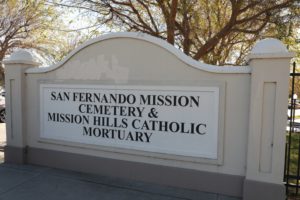
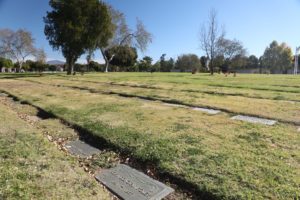
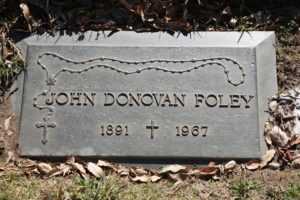
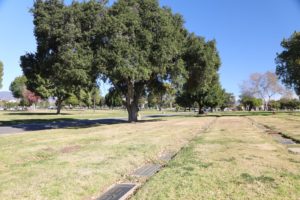
Greetings, Is your sold in Florida?
Daniel – their Florida distributor is: Angels’ Share South, 407-601-4951